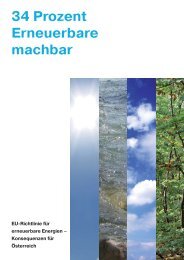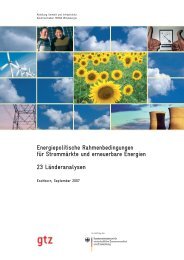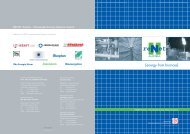K u rzfassu n g sb an d - Graz University of Technology
K u rzfassu n g sb an d - Graz University of Technology
K u rzfassu n g sb an d - Graz University of Technology
- Keine Tags gefunden...
Erfolgreiche ePaper selbst erstellen
Machen Sie aus Ihren PDF Publikationen ein blätterbares Flipbook mit unserer einzigartigen Google optimierten e-Paper Software.
60 Energieinnovation 2006<br />
3.2 Erdgas und Wasserst<strong>of</strong>f (Session C3)<br />
3.2.1 „The Europe<strong>an</strong> Natural Gas Sector until 2025 – Which Role for<br />
Russia <strong>an</strong>d LNG An Application <strong>of</strong> the GASMOD Model“<br />
Fr<strong>an</strong>ziska Holz*, (DIW – Germ<strong>an</strong> Institute for Economic Research) 1<br />
Christi<strong>an</strong> von Hirschhausen (TU Dresden) 2<br />
Natural gas supply to Europe is <strong>of</strong> utmost import<strong>an</strong>ce both for the Europe<strong>an</strong> countries, <strong>an</strong>d for current<br />
suppliers in the increasingly globalized markets. This paper proposes <strong>an</strong> application <strong>of</strong> the GASMOD<br />
model. GASMOD is a numerical simulation model <strong>of</strong> the Europe<strong>an</strong> natural gas sector, where imports<br />
to Europe <strong>an</strong>d wholesale trade within Europe are represented as a two-stage game. The market<br />
situation c<strong>an</strong> be modeled as perfect competition, Cournot competition or cartel on either <strong>of</strong> the two<br />
stages which enables us to simulate different market situations such as a successive oligopoly, a<br />
liberalized Europe<strong>an</strong> market, <strong>an</strong> export cartel, etc. The model includes 17 importing regions <strong>an</strong>d 13<br />
exporters where we distinguish pipeline <strong>an</strong>d LNG (Liquefied Natural Gas) supplies. We take into<br />
account infrastructure capacities since these c<strong>an</strong> be <strong>an</strong> import<strong>an</strong>t limitation to natural gas trade.<br />
In this paper we use the GASMOD model to investigate the role <strong>of</strong> Russia <strong>an</strong>d the role <strong>of</strong> LNG for the<br />
Europe<strong>an</strong> market until 2025. Russia is considered as <strong>an</strong> import<strong>an</strong>t supplier to Europe, <strong>an</strong>d current<br />
projects like the North Europe<strong>an</strong> Pipeline through the Baltic Sea <strong>an</strong>d the development <strong>of</strong> a field in the<br />
Barents Sea (Shtokm<strong>an</strong>) support this idea. However, natural gas production in Russia is relatively<br />
cost-intensive (mainly because <strong>of</strong> unfavorable climate conditions), <strong>an</strong>d the currently exploited fields<br />
are reaching depletion within the next years, forcing to bring on stream new fields with even higher<br />
costs <strong>of</strong> production. In addition, producers in Russia are faced with a domestic market where the<br />
regulated price still is lower th<strong>an</strong> the (long-run) marginal costs <strong>of</strong> production, which reduced the<br />
attractiveness <strong>of</strong> the Russi<strong>an</strong> natural gas sectors for investors in the production <strong>an</strong>d tr<strong>an</strong>sport<br />
infrastructure.<br />
In contrast, the LNG business is experiencing <strong>an</strong> increasing interest <strong>of</strong> investors in capacities at all<br />
stages <strong>of</strong> the value-added chain (liquefaction, shipping, regasification). Moreover, LNG costs have<br />
declined subst<strong>an</strong>tially in the last years <strong>an</strong>d some further cost reductions c<strong>an</strong> still be expected (e.g.<br />
economies <strong>of</strong> scale in liquefaction). This has lead to a shift in the structure <strong>of</strong> relative costs in the<br />
natural gas sector. LNG trade has also lead to a globalization <strong>of</strong> natural gas markets, which in turn<br />
favors the development <strong>of</strong> competition.<br />
We propose to study the outcome <strong>of</strong> these ch<strong>an</strong>ges on the Europe<strong>an</strong> natural gas trade. Our results<br />
show that market forces lead to a diversification <strong>of</strong> Europe<strong>an</strong> natural gas supplies. They confirm the<br />
deterioration <strong>of</strong> the Russi<strong>an</strong> position on the Europe<strong>an</strong> market, accomp<strong>an</strong>ied by increasing imports<br />
from LNG exporters (from North Africa, the Middle East, West Africa, <strong>an</strong>d the Caribbe<strong>an</strong>). LNG import<br />
(regasification) capacities could become a bottleneck in Europe, whereas export capacities (LNG <strong>an</strong>d<br />
pipeline) are largely sufficient to meet the rising dem<strong>an</strong>d for natural gas in Europe.<br />
Keywords: natural gas, strategic behavior, non-linear optimization, Europe<br />
1 DIW Berlin, Königin-Luise-Str. 5, 14195 Berlin; e-mail: fholz@diw.de, Url: www.diw.de;<br />
2 TU Dresden, Lehrstuhl für Energiewirtschaft, 01062 Dresden;<br />
e-mail: cvh@mailbox.tu-dresden.de, Url: www.ee2.biz;





